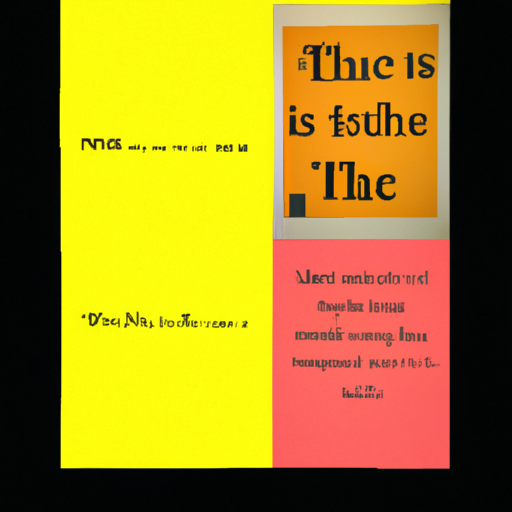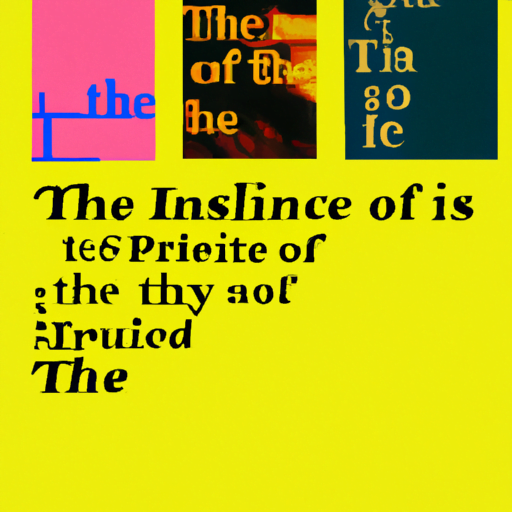
-
Table of Contents
The Influence of Typography in Poetry Book Design

Typography plays a crucial role in the design of poetry books, as it has the power to enhance the reader’s experience and convey the poet’s intended message. The choice of fonts, spacing, and layout can significantly impact how the reader engages with the poetry and interprets its meaning. In this article, we will explore the influence of typography in poetry book design and discuss its importance in creating a visually appealing and immersive reading experience.
The Role of Typography in Poetry
Typography is not merely a decorative element in poetry book design; it is an essential tool for conveying the poet’s emotions and intentions. The right typography can evoke specific moods, emphasize certain words or phrases, and guide the reader’s interpretation of the poem. Here are some key ways in which typography influences the reading experience:
- Setting the Tone: The choice of font, size, and style can set the overall tone of the poetry book. For example, a bold and modern font may suggest a contemporary and experimental collection, while a classic serif font may evoke a sense of tradition and timelessness.
- Emphasizing Words and Phrases: Typography allows poets to emphasize specific words or phrases to create impact and guide the reader’s attention. By using bold, italic, or larger fonts, poets can draw attention to key elements of their work.
- Creating Visual Rhythm: The arrangement of words and lines on the page can create a visual rhythm that complements the poem’s rhythm and enhances its musicality. The spacing between lines and stanzas can also influence the reader’s pace and breathing while reading the poem.
- Enhancing Readability: Typography choices such as font size, line spacing, and margins can significantly impact the readability of the poetry book. A well-designed layout ensures that the text is easy to read and allows the reader to fully immerse themselves in the poet’s words.
Case Studies: Typography in Poetry Book Design
Let’s explore some real-world examples of how typography has been used effectively in poetry book design:
1. “Milk and Honey” by Rupi Kaur
Rupi Kaur’s “Milk and Honey” is a bestselling poetry collection that gained popularity for its raw and honest portrayal of love, loss, and healing. The typography in this book is minimalistic yet impactful. The use of lowercase letters and simple sans-serif fonts creates a sense of vulnerability and intimacy, reflecting the personal nature of the poems. The generous spacing between lines and stanzas allows the reader to pause and reflect on each verse, enhancing the emotional impact of the words.
2. “The Waste Land” by T.S. Eliot
T.S. Eliot’s “The Waste Land” is a modernist masterpiece that explores themes of disillusionment and despair. The typography in this poem is fragmented and visually complex, mirroring the fragmented nature of the modern world. The use of different fonts, sizes, and styles creates a sense of chaos and disorientation, challenging the reader to actively engage with the text and decipher its meaning. The unconventional layout and spacing add to the poem’s overall sense of unease and instability.
The Psychology of Typography in Poetry
Typography has a profound psychological impact on readers, and this is particularly true in the context of poetry. Here are some ways in which typography influences the reader’s perception and interpretation of poetry:
- Emotional Connection: The right typography can evoke specific emotions and create a deeper connection between the reader and the poem. For example, a flowing and elegant script font may evoke a sense of romance or nostalgia, while a bold and angular font may convey strength and intensity.
- Visual Hierarchy: Typography helps establish a visual hierarchy within the poem, guiding the reader’s attention and emphasizing key elements. By using different font sizes, styles, and weights, poets can create a sense of importance and hierarchy within their work.
- Reader Engagement: Well-designed typography can enhance the reader’s engagement with the poem by creating a visually pleasing and immersive reading experience. When the typography complements the poem’s content and style, it encourages the reader to spend more time with the text and explore its deeper meanings.
The Importance of Typography in Poetry Book Design
Typography is a critical aspect of poetry book design, as it can make or break the reader’s experience. Here are some reasons why typography should be given careful consideration in the design process:
- Reflecting the Poet’s Voice: Typography choices should align with the poet’s voice and style, enhancing the overall message and tone of the poems. The typography should be a visual representation of the poet’s artistic vision.
- Creating a Memorable Reading Experience: A well-designed typography can make the poetry book more memorable and impactful. When typography is used effectively, it can leave a lasting impression on the reader and make the poems more memorable.
- Setting the Book Apart: In a crowded market, typography can help a poetry book stand out from the competition. A unique and visually appealing typography can catch the reader’s attention and make them more likely to pick up the book.
- Enhancing Accessibility: Good typography improves the accessibility of the poetry book by ensuring that the text is easy to read for people with visual impairments or reading difficulties. Clear fonts, appropriate font sizes, and sufficient contrast can make the poems accessible to a wider audience.
Summary
Typography plays a vital role in poetry book design, influencing the reader’s experience and interpretation of the poems. The right typography can set the tone, emphasize key elements, create visual rhythm, and enhance readability. Real-world examples such as “Milk and Honey” and “The Waste Land” demonstrate how typography can be used effectively in poetry book design. Additionally, typography has a psychological impact on readers, evoking emotions, establishing visual hierarchy, and enhancing reader engagement. Considering the importance of typography in creating a memorable reading experience, it is crucial for poets and designers to carefully select fonts, spacing, and layout that align with the poet’s voice and style. By doing so, they can create visually appealing and immersive poetry books that leave a lasting impression on the reader.
